Door Number Two Revisited – Part I: Re-inflation theory and practice
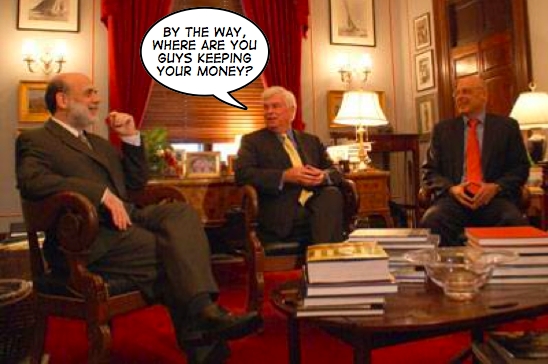
EJ: It’s not a “bull market.” The whole idiotic idea of bull and bear markets is a Wall Street product sales concept. Forget it. Markets are a battleground. The fight is over money. The weapons are information and control of information. The determinant of the winner is purchasing power, who is gaining it and who is losing it, via taxation, deregulation, subsidies, inflation, or leverage. The rest is BS. With that as background, no, I don’t think last week’s gold and silver price volatility indicates that a decade long rise in the gold price is over. It’s more of the same, although showtime is approaching.
CI: Showtime?
EJ: We bought gold in 2001 because we thought global central banks protested too much about the worthlessness of gold as a monetary asset; they said it had no value yet they hung on to more than 20% of all the gold ever produced in history. We figured they were hedging the potential failure of a grand experiment, of a reserve currency based on the debt money of a single sovereign state, the USA. The Iraq War in 2003 and the collapse of the global credit markets in 2008 due to mis-rating and thus mis-pricing of asset-backed securities supplied ample evidence to members of The System, as Greenspan used to call it, that the country issuing said reserve currency is not only systemically corrupt, as is any plutocracy, but venally corrupt, in the words of Simon Johnson, run by financial oligarchy. The US cannot be trusted. An alternative monetary arrangement is needed. That’s what the pushing and shoving going into the G20 last week was about. Reading the World Bank’s trial balloon about using gold in a new currency arrangement, Volcker’s off-the-reservation remarks about the dangers of QE2, and Greenspan’s assertion that the US is intentionally depreciating the dollar as a reflation tool, it should be obvious to even a casual observer that we’re not in Kansas anymore. Tensions are high, and anything could happen.
CI: How were last week's gold price movements related to the G20?
EJ: Pure speculation, but it looks like there was a $50 ramp-up going into the meeting as the market priced in discord among G20 members. Then we saw two synchronized gold and silver price take-downs over the past week, one before the meeting on November 9 and another during the meeting on November 12. These shaved 4% off the $1,421 peak gold price.
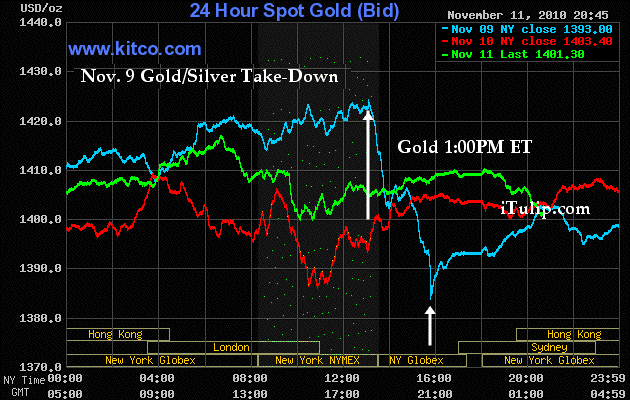
I’ve seen these coordinated gold and silver price changes many times over the years, such as on June 22, 2008 when gold dropped from $904 to $875 and silver from $17.30 to $16.50.
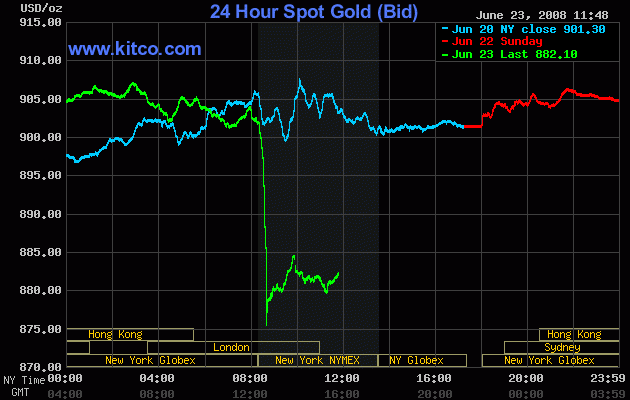
CI: What do these coordinated gold and silver price drops mean?
EJ: You can be pretty sure that programmatic fund buying and selling is responsible, but I’m comfortable with the conclusion we came to when we studied it in June 2008: no one knows for sure. All I am sure of is that there is no long-term relevance. If you think that a broken global trade and monetary system that’s been breaking down for ten years will be corrected in a few meetings among Harvard business school graduates, then by all means sell gold and buy stocks.
Wall Street’s trade press reported the 4% drop under headlines such as “Gold Slaughtered.” Let’s see how bad the slaughter of gold has been compared to stocks this year.
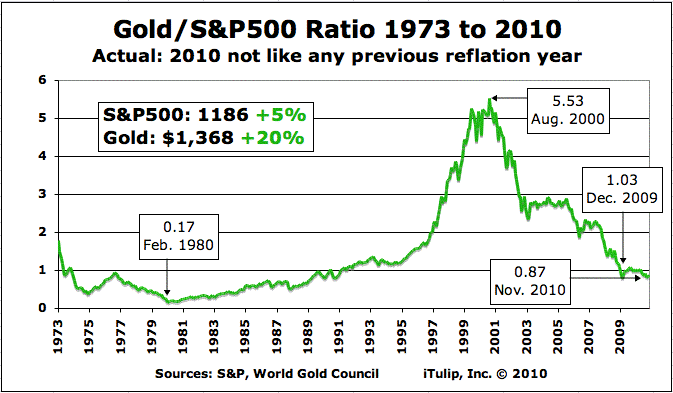
Ratio of average monthly gold price versus average monthly S&P500
Gold is up 20% in 2010 compared to 5% for the S&P500 on an average monthly basis. Some slaughter. This chart will be updated for our December year end roundup that reviews my gold and stock market forecasts for the 2010 post-recession reflation year.
CI: You said you had an update of the 10-year chart.
EJ: Here it is. 2010 will mark the tenth consecutive year of gold price gains.
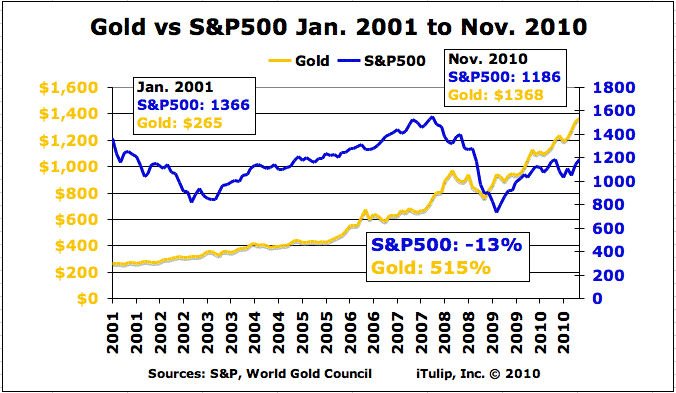
Average monthly gold price versus average monthly S&P500 January 2001 to November 2010
What’s a “hedge” anyway?
CI: Gold isn’t supposed to beat stocks over the long run.
EJ: The perverse thing about the performance of our gold and Treasury bond portfolio is that gold and Treasury bonds are though of as hedges against drawdowns in core assets, especially equities, but the supposedly short-term hedges have outperformed the long-term core asset positions that they are supposed to be hedging. We only own the hedges, not the assets they are suppose to hedge.
CI: If gold did so much better this year than you expected, what’s in store for next year?
EJ: Keep in mind that the key driver for the gold price in 2010 was reflation, and the primary driver of reflation was dollar depreciation, which is making China, Brazil, and the entire G20 is pissed off going into last week’s meetings.
CI: So no big gold correction is coming?
EJ: I didn’t say that. Since 2001 we have ridden out two major gold market corrections, one in 2006 and 2008. We have not issued a price warning on gold since March 5, 2008 when gold traded at $974. Back then, in Gold Update: The small trade within the big trade we warned that a $200 correction was coming. The correction began two weeks later, after gold prices briefly passed above $1000.
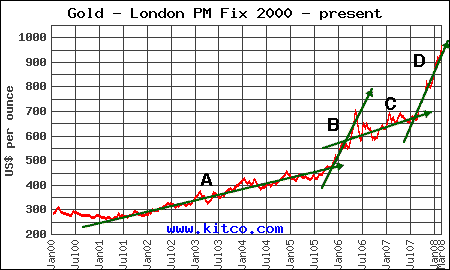
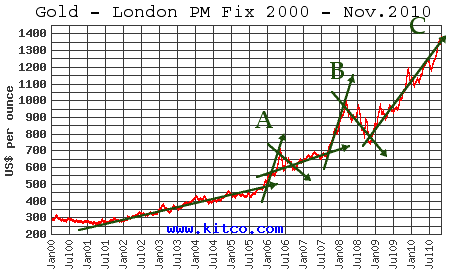
Two major gold price corrections during the ten year run-up
The chart shows the correction we forecast in March 2008 to start in that month did in fact start in March 2008. The reflation run-up has gone on all the way through the US midterm elections and up to the G20. With 20% gains so far this year gold prices are far ahead of the 4% rise I forecast in January.
CI: Might the two gold price corrections “A” and “B” in 2006 and 2008 respectively be followed by a third “C” soon?
EJ: Well, it is getting to be time for someone to do something stupid. Once governments paint themselves this far into a corner, the only way out is either to step on the pain or knock a hole in the wall.
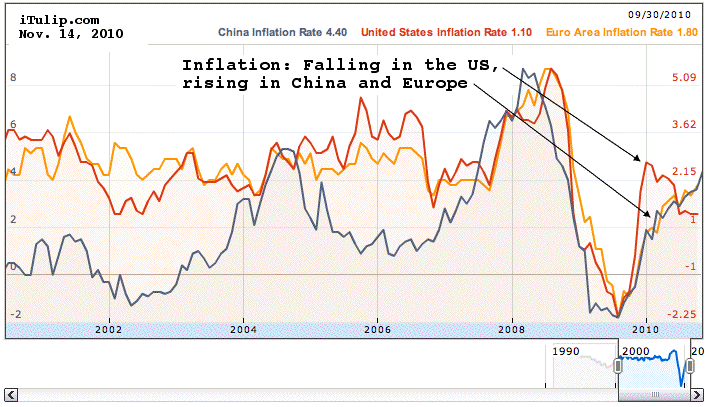
America’s debt deflation defenses of currency depreciation and quantitative easing are creating a capital inflow and inflation crisis for Europe, Asia, and Latin America.
The domestic consequences of failing to write off the credit bubble era debt is chronic high unemployment and inflationary policies to close the so-called Output Gap that have the effect of rising inflation in the economies of US trade partners. Not everyone is going to get what they want.
CI: And your December 2010 forecast of the DJIA to 7000 to 8000 by the end of the year?
EJ: Doesn’t look likely from here.
CI: But it did top out near 11,000 as you forecast.
EJ: Right. The question was, how high will the Second Bounce of the Debt Deflation Bear Market go? I was off by four months on the timing of the end of the first bounce. It ended in April 2010 not December 2009. I still see a DJIA in the 7000 to 8000 range, but maybe that takes a few months longer than I thought back in January. The question for stocks is reflation policy. The new gridlock Congress won’t get any cuts through, but it won’t get any stimulus through either unless there’s urgency. A bubble collapse in China might create that urgency. We’ll keep an eye on it.
CI: Do you think we’re due for another gold price correction like the one we had in 2008?
EJ: Not like 2008. The structure of the private credit markets is not even close to what it was in 2008. No one is that stupid anymore. No one believes that US credit rating agencies are independent. Look at the market for asset-backed commercial paper.
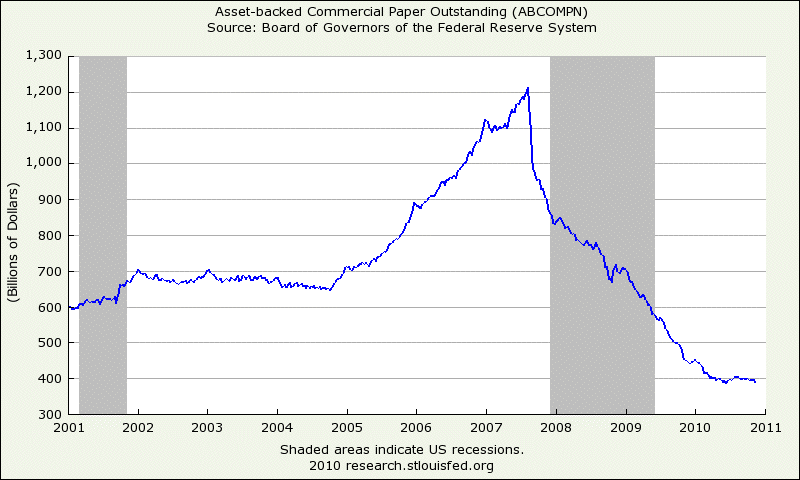
Asset-backed commercial paper 2001 to 2010
No one believes that an Agency bond is “risk free” nor is a US Treasury bond. There’s zero default risk, but inflation risk is there. Greenspan is openly warning about that today.
CI: How the world has changed in three years! Is “austerity” is the next policy wave that brings down commodity prices?
EJ: Leverage is now on public not private balance sheets, so a repeat of a 2008 deflationary impulse is not in the cards. That’s was much “deflation” as we’ll see in our lifetimes. But it's critical to distinguish between the US and EU. Fund managers may expect so-called “austerity” measures to reduce sovereign credit risks over time, but I think all efforts to cut government spending short-term will be thwarted by rising energy costs long-term, given the vise of high commodity prices, debt payments, and low wages that grips the American middle class. At the moment, sovereign credit risk in Europe is worse than in the US.
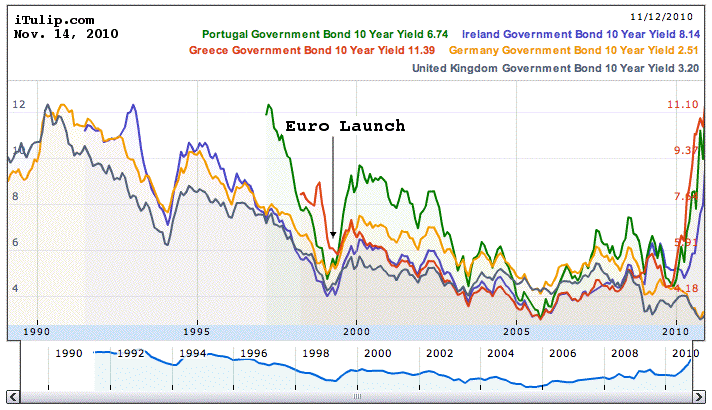
This is helping to push US Treasury bond yields down.
CI: How deep a gold price correction might we see?
EJ: We may see a correction of up to 20% over the next 12 months, but I am reluctant to say that because unlike the warning in March 2008, the driver this time is neither as clear nor as certain. Frankly, it’s based on little more than intuition.
CI: What’s bugging you?
EJ: Central banks hate high priced gold. It makes them look incompetent. In a perfect world according to central bankers, gold prices were supposed to fall from $35 to $7.50 after 1971 when gold was demonetized but instead shot up to $850. For 16 years, from 1987 to 2003, the system worked pretty well, but even though central banks do not report to national governments they are certainly accountable to them. The Iraq War started the dissolution of the previously cozy relationship. When the US crashed the global financial system in 2008, that was the last straw for many leaders around the world.
At this point, there are numerous potential sources of the next major correction in gold and commodity prices. One, forcing the US to halt its currency depreciation, is one. Actual implementation of austerity in the US is another. I assign a near zero probability to that. Austerity, as I noted early in the year, is a campaign promise that will get you elected. No politician wants the spending plug pulled on their watch if they can help it. Another possibility is the perception that the currency war that started in 2001, but was not named publicly until this year – by Brazil – may be nearing an end. It isn’t, but the gold price correction immediately before and during the G20 likely reflects speculation and information leaks that might be taken for indications that a new monetary arrangement is at hand. Gold ran up before the meeting on news of discord and may be correcting on rumors of cooperation, especially what appear to be concessions by the US to stop beggaring its trade partners. Funds are trading on the rumors. Gold is a barometer of central bank discord. Given that the G20 ended without any resolutions to the trade and currency conflicts, if gold prices rise on Monday, we’ll have our answer.
CI: What do you make of Greenspan’s statement the day before the start of the G20? He said the U.S. was "pursuing a policy of currency weakening."
EJ: Greenspan, not my favorite person [http://www.itulip.com/aginterview.htm], followed up Volcker’s off-the-reservation remarks on the efficacy of QE2 by stating the obvious, that the US is using currency depreciation not only to boost imports but, as we’ve warned for years, to hold off debt deflation or escape a liquidity trap The Foolproof Way.
CI: The Foolproof Way?
EJ: That’s a phrase attentive readers will remember from my early 2007 forecasts here: currency depreciation. It’s not about boosting exports, as most commentators today believe. It’s not about beggar thy neighbor with a weak currency to boost exports. It’s about debt deflation. The US is in a balance sheet recession. If the US allows the dollar to appreciate it loses the primary source of inflation signals into the economy, from energy and import prices. I can just see the PowerPoint presentations now. There’s the US representative explaining the dangers of deflation in the US. There’s the representative from China countering that debt deflation management via currency depreciation worked for the US in 1933 but it’s not 1933. The US is a debtor country now and America’s creditors are on the receiving end of US debt deflation policy. China is demanding to be repaid in fully valued dollars. We want a weaker RMB? We can raise our interest rates. But that will crash our economy, the US side responds. And so on. No wonder they didn’t get anywhere. If the US did cave, a rising dollar will quickly send the US back into recession and deflation. With a deadlocked Congress, a fresh crisis will be needed to create a consensus to deploy new fiscal stimulus measures. In that window, all markets, including gold, may suffer from a rush to liquidity. But again this is all speculation. There is simply no way of knowing.
CI: The MSM story is that China may raise interest rates to combat inflation and that’s sending gold lower.
EJ: Maybe. But this is why it’s a waste of time to try to understand short-term gold price movements. If in fact China does raise rates and crash its economy in its second attempt to shrink its housing bubble, how low will gold go before fresh reflation measures begin? $1200? $1000? And what effect will those measures have? To push gold to $2000? $5000?
CI Final words on gold before we move on?
EJ: The past 10 years of gold prices is about who wins and who loses in the next big play of The Game. Embrace ambiguity. Look for anomalies and contradictions in the storyline proffered by the Bullhorn.
(See Lessons of the American Lost Decade – Part I: The gold bugs were right)
Door Number Two revisited – Part II: The bed we’ve made

“God runs electromagnetics by wave theory on Monday, Wednesday, and Friday, and the Devil runs them by quantum theory on Tuesday, Thursday, and Saturday.”
- Sir William Bragg
An ounce of action is worth a ton of theory.
- Friedrich Engels (1820 - 1895)
CI: How was your trip to London last week?
EJ: Very good. Made delightful new friends.
CI: You were there during the tuition riots?
EJ: Yes, throughout the afternoon, police streamed toward Westminster, sirens blaring. Walking to a meeting in late afternoon, I passed a Metropolitan Police station when a paddy wagon full of demonstrators pulled up and the passengers were escorted out while police with automatic weapons stood by. Quite a scene.
CI: How was it covered by the local media? What’s your interpretation?
EJ: Most of the British media covered it as a peaceful protest gone wrong when a minority of troublemakers hijacked it. What interested me is not so much violence of the anarchists. They are dedicated to the use of violence. But the reaction of the students who are not part of the anarchist movement was possibly significant. Clearly many of the peaceful groups were unhappy with the hijacking but also some who said, “Well, if peaceful protest is ineffectual, then maybe this is the only way.” Others were got caught up in the thrill of violence. Violence is intoxicating and communicable. more... $ubscription
iTulip Select: The Investment Thesis for the Next Cycle™
__________________________________________________
For a concise, readable summary of iTulip concepts read Eric Janszen's September 2010 book The Postcatastrophe Economy: Rebuilding America and Avoiding the Next Bubble .
.
To receive the iTulip Newsletter/Alerts, Join our FREE Email Mailing List
To join iTulip forum community FREE, click here for how to register.
Copyright © iTulip, Inc. 1998 - 2010 All Rights Reserved
All information provided "as is" for informational purposes only, not intended for trading purposes or advice. Nothing appearing on this website should be considered a recommendation to buy or to sell any security or related financial instrument. iTulip, Inc. is not liable for any informational errors, incompleteness, or delays, or for any actions taken in reliance on information contained herein. Full Disclaimer

“In theory, the balance sheet of the Federal Reserve can be expanded infinitely.”
- Alan Greenspan, 2005
“If the facts don't fit the theory, change the facts.”
- Albert Einstein
CI: Let’s start with the urgent item on the table. What the heck is going on with gold? Is this The Big Volatility you’ve warned about since 2001 that spells the end of the gold bull market?- Alan Greenspan, 2005
“If the facts don't fit the theory, change the facts.”
- Albert Einstein
EJ: It’s not a “bull market.” The whole idiotic idea of bull and bear markets is a Wall Street product sales concept. Forget it. Markets are a battleground. The fight is over money. The weapons are information and control of information. The determinant of the winner is purchasing power, who is gaining it and who is losing it, via taxation, deregulation, subsidies, inflation, or leverage. The rest is BS. With that as background, no, I don’t think last week’s gold and silver price volatility indicates that a decade long rise in the gold price is over. It’s more of the same, although showtime is approaching.
CI: Showtime?
EJ: We bought gold in 2001 because we thought global central banks protested too much about the worthlessness of gold as a monetary asset; they said it had no value yet they hung on to more than 20% of all the gold ever produced in history. We figured they were hedging the potential failure of a grand experiment, of a reserve currency based on the debt money of a single sovereign state, the USA. The Iraq War in 2003 and the collapse of the global credit markets in 2008 due to mis-rating and thus mis-pricing of asset-backed securities supplied ample evidence to members of The System, as Greenspan used to call it, that the country issuing said reserve currency is not only systemically corrupt, as is any plutocracy, but venally corrupt, in the words of Simon Johnson, run by financial oligarchy. The US cannot be trusted. An alternative monetary arrangement is needed. That’s what the pushing and shoving going into the G20 last week was about. Reading the World Bank’s trial balloon about using gold in a new currency arrangement, Volcker’s off-the-reservation remarks about the dangers of QE2, and Greenspan’s assertion that the US is intentionally depreciating the dollar as a reflation tool, it should be obvious to even a casual observer that we’re not in Kansas anymore. Tensions are high, and anything could happen.
CI: How were last week's gold price movements related to the G20?
EJ: Pure speculation, but it looks like there was a $50 ramp-up going into the meeting as the market priced in discord among G20 members. Then we saw two synchronized gold and silver price take-downs over the past week, one before the meeting on November 9 and another during the meeting on November 12. These shaved 4% off the $1,421 peak gold price.

I’ve seen these coordinated gold and silver price changes many times over the years, such as on June 22, 2008 when gold dropped from $904 to $875 and silver from $17.30 to $16.50.

CI: What do these coordinated gold and silver price drops mean?
EJ: You can be pretty sure that programmatic fund buying and selling is responsible, but I’m comfortable with the conclusion we came to when we studied it in June 2008: no one knows for sure. All I am sure of is that there is no long-term relevance. If you think that a broken global trade and monetary system that’s been breaking down for ten years will be corrected in a few meetings among Harvard business school graduates, then by all means sell gold and buy stocks.
Wall Street’s trade press reported the 4% drop under headlines such as “Gold Slaughtered.” Let’s see how bad the slaughter of gold has been compared to stocks this year.

Ratio of average monthly gold price versus average monthly S&P500
Gold is up 20% in 2010 compared to 5% for the S&P500 on an average monthly basis. Some slaughter. This chart will be updated for our December year end roundup that reviews my gold and stock market forecasts for the 2010 post-recession reflation year.
CI: You said you had an update of the 10-year chart.
EJ: Here it is. 2010 will mark the tenth consecutive year of gold price gains.

Average monthly gold price versus average monthly S&P500 January 2001 to November 2010
What’s a “hedge” anyway?
CI: Gold isn’t supposed to beat stocks over the long run.
EJ: The perverse thing about the performance of our gold and Treasury bond portfolio is that gold and Treasury bonds are though of as hedges against drawdowns in core assets, especially equities, but the supposedly short-term hedges have outperformed the long-term core asset positions that they are supposed to be hedging. We only own the hedges, not the assets they are suppose to hedge.
CI: If gold did so much better this year than you expected, what’s in store for next year?
EJ: Keep in mind that the key driver for the gold price in 2010 was reflation, and the primary driver of reflation was dollar depreciation, which is making China, Brazil, and the entire G20 is pissed off going into last week’s meetings.
CI: So no big gold correction is coming?
EJ: I didn’t say that. Since 2001 we have ridden out two major gold market corrections, one in 2006 and 2008. We have not issued a price warning on gold since March 5, 2008 when gold traded at $974. Back then, in Gold Update: The small trade within the big trade we warned that a $200 correction was coming. The correction began two weeks later, after gold prices briefly passed above $1000.

Since 2001, the gold price has increased in four distinct growth trends as depicted above.
A. 2001 - 2006: Post-bubble gradual currency depreciation and inflation trade
B. H1 2006: Rapid speculative trade
C. H2 2006 - 2007: Resumption of gradual currency depreciation and inflation trade
D. 2007 - Present: New rapid speculative trade
As it turned out, the correction was deeper than I expected, closer to $300 than $200, falling all the way to $712 in October, reflecting the full force of the collapse of the global private credit markets on non-dollar investments before reflation and bailouts kicked in. Here is that chart updated to today.A. 2001 - 2006: Post-bubble gradual currency depreciation and inflation trade
B. H1 2006: Rapid speculative trade
C. H2 2006 - 2007: Resumption of gradual currency depreciation and inflation trade
D. 2007 - Present: New rapid speculative trade

Two major gold price corrections during the ten year run-up
The chart shows the correction we forecast in March 2008 to start in that month did in fact start in March 2008. The reflation run-up has gone on all the way through the US midterm elections and up to the G20. With 20% gains so far this year gold prices are far ahead of the 4% rise I forecast in January.
CI: Might the two gold price corrections “A” and “B” in 2006 and 2008 respectively be followed by a third “C” soon?
EJ: Well, it is getting to be time for someone to do something stupid. Once governments paint themselves this far into a corner, the only way out is either to step on the pain or knock a hole in the wall.

America’s debt deflation defenses of currency depreciation and quantitative easing are creating a capital inflow and inflation crisis for Europe, Asia, and Latin America.
The domestic consequences of failing to write off the credit bubble era debt is chronic high unemployment and inflationary policies to close the so-called Output Gap that have the effect of rising inflation in the economies of US trade partners. Not everyone is going to get what they want.
CI: And your December 2010 forecast of the DJIA to 7000 to 8000 by the end of the year?
EJ: Doesn’t look likely from here.
CI: But it did top out near 11,000 as you forecast.
EJ: Right. The question was, how high will the Second Bounce of the Debt Deflation Bear Market go? I was off by four months on the timing of the end of the first bounce. It ended in April 2010 not December 2009. I still see a DJIA in the 7000 to 8000 range, but maybe that takes a few months longer than I thought back in January. The question for stocks is reflation policy. The new gridlock Congress won’t get any cuts through, but it won’t get any stimulus through either unless there’s urgency. A bubble collapse in China might create that urgency. We’ll keep an eye on it.
CI: Do you think we’re due for another gold price correction like the one we had in 2008?
EJ: Not like 2008. The structure of the private credit markets is not even close to what it was in 2008. No one is that stupid anymore. No one believes that US credit rating agencies are independent. Look at the market for asset-backed commercial paper.

Asset-backed commercial paper 2001 to 2010
No one believes that an Agency bond is “risk free” nor is a US Treasury bond. There’s zero default risk, but inflation risk is there. Greenspan is openly warning about that today.
CI: How the world has changed in three years! Is “austerity” is the next policy wave that brings down commodity prices?
EJ: Leverage is now on public not private balance sheets, so a repeat of a 2008 deflationary impulse is not in the cards. That’s was much “deflation” as we’ll see in our lifetimes. But it's critical to distinguish between the US and EU. Fund managers may expect so-called “austerity” measures to reduce sovereign credit risks over time, but I think all efforts to cut government spending short-term will be thwarted by rising energy costs long-term, given the vise of high commodity prices, debt payments, and low wages that grips the American middle class. At the moment, sovereign credit risk in Europe is worse than in the US.

This is helping to push US Treasury bond yields down.
CI: How deep a gold price correction might we see?
EJ: We may see a correction of up to 20% over the next 12 months, but I am reluctant to say that because unlike the warning in March 2008, the driver this time is neither as clear nor as certain. Frankly, it’s based on little more than intuition.
CI: What’s bugging you?
EJ: Central banks hate high priced gold. It makes them look incompetent. In a perfect world according to central bankers, gold prices were supposed to fall from $35 to $7.50 after 1971 when gold was demonetized but instead shot up to $850. For 16 years, from 1987 to 2003, the system worked pretty well, but even though central banks do not report to national governments they are certainly accountable to them. The Iraq War started the dissolution of the previously cozy relationship. When the US crashed the global financial system in 2008, that was the last straw for many leaders around the world.
At this point, there are numerous potential sources of the next major correction in gold and commodity prices. One, forcing the US to halt its currency depreciation, is one. Actual implementation of austerity in the US is another. I assign a near zero probability to that. Austerity, as I noted early in the year, is a campaign promise that will get you elected. No politician wants the spending plug pulled on their watch if they can help it. Another possibility is the perception that the currency war that started in 2001, but was not named publicly until this year – by Brazil – may be nearing an end. It isn’t, but the gold price correction immediately before and during the G20 likely reflects speculation and information leaks that might be taken for indications that a new monetary arrangement is at hand. Gold ran up before the meeting on news of discord and may be correcting on rumors of cooperation, especially what appear to be concessions by the US to stop beggaring its trade partners. Funds are trading on the rumors. Gold is a barometer of central bank discord. Given that the G20 ended without any resolutions to the trade and currency conflicts, if gold prices rise on Monday, we’ll have our answer.
CI: What do you make of Greenspan’s statement the day before the start of the G20? He said the U.S. was "pursuing a policy of currency weakening."
EJ: Greenspan, not my favorite person [http://www.itulip.com/aginterview.htm], followed up Volcker’s off-the-reservation remarks on the efficacy of QE2 by stating the obvious, that the US is using currency depreciation not only to boost imports but, as we’ve warned for years, to hold off debt deflation or escape a liquidity trap The Foolproof Way.
CI: The Foolproof Way?
EJ: That’s a phrase attentive readers will remember from my early 2007 forecasts here: currency depreciation. It’s not about boosting exports, as most commentators today believe. It’s not about beggar thy neighbor with a weak currency to boost exports. It’s about debt deflation. The US is in a balance sheet recession. If the US allows the dollar to appreciate it loses the primary source of inflation signals into the economy, from energy and import prices. I can just see the PowerPoint presentations now. There’s the US representative explaining the dangers of deflation in the US. There’s the representative from China countering that debt deflation management via currency depreciation worked for the US in 1933 but it’s not 1933. The US is a debtor country now and America’s creditors are on the receiving end of US debt deflation policy. China is demanding to be repaid in fully valued dollars. We want a weaker RMB? We can raise our interest rates. But that will crash our economy, the US side responds. And so on. No wonder they didn’t get anywhere. If the US did cave, a rising dollar will quickly send the US back into recession and deflation. With a deadlocked Congress, a fresh crisis will be needed to create a consensus to deploy new fiscal stimulus measures. In that window, all markets, including gold, may suffer from a rush to liquidity. But again this is all speculation. There is simply no way of knowing.
CI: The MSM story is that China may raise interest rates to combat inflation and that’s sending gold lower.
EJ: Maybe. But this is why it’s a waste of time to try to understand short-term gold price movements. If in fact China does raise rates and crash its economy in its second attempt to shrink its housing bubble, how low will gold go before fresh reflation measures begin? $1200? $1000? And what effect will those measures have? To push gold to $2000? $5000?
CI Final words on gold before we move on?
EJ: The past 10 years of gold prices is about who wins and who loses in the next big play of The Game. Embrace ambiguity. Look for anomalies and contradictions in the storyline proffered by the Bullhorn.
(See Lessons of the American Lost Decade – Part I: The gold bugs were right)
Door Number Two revisited – Part II: The bed we’ve made

“God runs electromagnetics by wave theory on Monday, Wednesday, and Friday, and the Devil runs them by quantum theory on Tuesday, Thursday, and Saturday.”
- Sir William Bragg
An ounce of action is worth a ton of theory.
- Friedrich Engels (1820 - 1895)
CI: How was your trip to London last week?
EJ: Very good. Made delightful new friends.
CI: You were there during the tuition riots?
EJ: Yes, throughout the afternoon, police streamed toward Westminster, sirens blaring. Walking to a meeting in late afternoon, I passed a Metropolitan Police station when a paddy wagon full of demonstrators pulled up and the passengers were escorted out while police with automatic weapons stood by. Quite a scene.
CI: How was it covered by the local media? What’s your interpretation?
EJ: Most of the British media covered it as a peaceful protest gone wrong when a minority of troublemakers hijacked it. What interested me is not so much violence of the anarchists. They are dedicated to the use of violence. But the reaction of the students who are not part of the anarchist movement was possibly significant. Clearly many of the peaceful groups were unhappy with the hijacking but also some who said, “Well, if peaceful protest is ineffectual, then maybe this is the only way.” Others were got caught up in the thrill of violence. Violence is intoxicating and communicable. more... $ubscription
iTulip Select: The Investment Thesis for the Next Cycle™
__________________________________________________
For a concise, readable summary of iTulip concepts read Eric Janszen's September 2010 book The Postcatastrophe Economy: Rebuilding America and Avoiding the Next Bubble
 .
.To receive the iTulip Newsletter/Alerts, Join our FREE Email Mailing List
To join iTulip forum community FREE, click here for how to register.
Copyright © iTulip, Inc. 1998 - 2010 All Rights Reserved
All information provided "as is" for informational purposes only, not intended for trading purposes or advice. Nothing appearing on this website should be considered a recommendation to buy or to sell any security or related financial instrument. iTulip, Inc. is not liable for any informational errors, incompleteness, or delays, or for any actions taken in reliance on information contained herein. Full Disclaimer
Comment